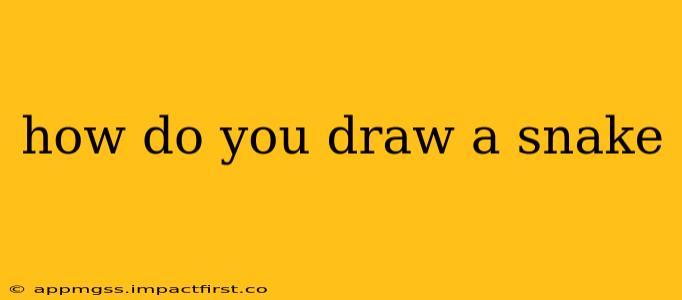How to Draw a Snake: A Step-by-Step Guide for Beginners and Beyond
Drawing a snake might seem daunting, but with a little practice and the right techniques, you can create realistic and captivating serpentine artwork. This guide will walk you through several methods, catering to different skill levels, from simple outlines to more detailed and textured depictions.
Understanding Snake Anatomy: Before we begin, let's briefly touch upon the key anatomical features that will help you create a believable snake. Snakes are characterized by their elongated bodies, lack of limbs, and scales. Understanding how these elements work together will improve your drawing significantly. Think about the subtle curves and bends of the body, the way the scales overlap, and the placement of the head and tail.
Method 1: The Simple, Cartoonish Snake
This method is perfect for beginners or those looking for a quick and easy approach.
- Draw a long, slightly curved line: This will form the snake's body. Think of a gentle "S" shape, but feel free to make it more winding.
- Add a small oval at one end: This is the head.
- Draw a small triangle or forked tongue at the bottom of the head: This adds character and identifies it as a snake.
- Add a small, pointed oval at the other end: This is the tail.
- Optional: Add simple scales: You can add a few slightly overlapping oval shapes along the body to suggest scales.
Method 2: A More Realistic Snake
This method incorporates more detail and realism.
- Start with the head: Begin by drawing a slightly elongated oval or teardrop shape for the head. Add details like eyes, nostrils, and possibly fangs depending on the type of snake you want to depict.
- Sketch the body: Draw a series of curved lines connected to the head, gradually tapering towards the tail. Don't make the lines perfectly smooth; snakes have a subtle, unevenness to their bodies. Vary the curves to create movement and dynamism.
- Add the scales: Use small, overlapping shapes to represent the scales. Vary the size and shape of the scales for a more natural look. Focus on the overlapping patterns – this is crucial for realism.
- Refine the lines and add details: Once you're happy with the basic shape, refine the lines, adding shadows and highlights to give the snake depth and dimension. Consider adding texture to the scales.
Method 3: Drawing a Coiled Snake
Coiled snakes present a unique challenge.
- Start with a central oval or circle: This represents the core of the coil.
- Add concentric curves: Draw additional curves around the central shape, creating the coils of the snake's body. Consider the way the coils overlap and interlock.
- Add the head and tail: Carefully place the head and tail within or outside the coil, depending on your composition.
- Add scales and details: Once the coils are defined, add scales and details to make the drawing more realistic. Remember to consider the perspective and how the scales appear as they wrap around the coils.
What materials should I use?
You can use a variety of materials to draw a snake, including pencils (HB, 2B, 4B for shading), charcoal, colored pencils, or even pens. Choose what feels comfortable for you and what allows you to achieve the level of detail you’re aiming for.
What are some common mistakes to avoid when drawing a snake?
- Making the body too uniform: Snakes have subtle curves and variations in their body thickness.
- Neglecting scale detail: Scales are an essential feature of snakes. Don't overlook the importance of adding them.
- Forgetting about the head and tail: These are key features that give your snake character.
- Ignoring perspective: If your snake is coiled or in a specific pose, be mindful of how perspective affects its shape and form.
By following these steps and practicing regularly, you'll be able to confidently draw a variety of snakes, from simple cartoons to highly realistic depictions. Remember to observe real snakes (pictures or videos are fine!) to understand their anatomy and movement better. Happy drawing!
